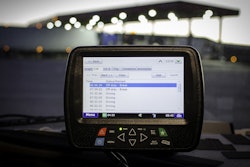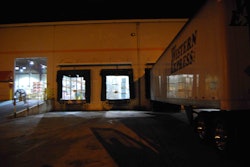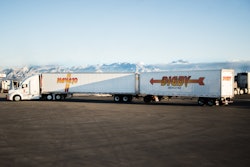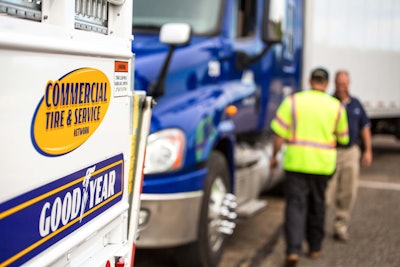
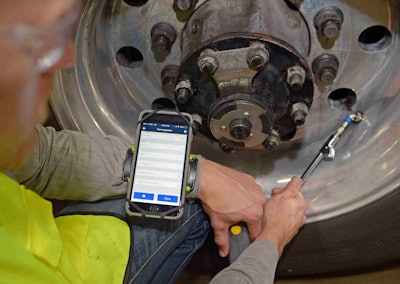
Commercial tires require expert management to help ensure optimal performance and minimize expensive truck downtime.
Goodyear Marketing Manager Dustin Lancy says an increasing number of fleets are opting to farm out tire maintenance responsibilities to tire professionals, which in turn frees that formerly dedicated personnel – as well the allocated time and resources – that previously could have been detracting from the fleet’s core business of moving freight.
“The experts at these locations have the experience and expertise to establish tire management programs that are tailored to meet a fleet’s unique needs and help ensure that the fleet is optimizing its tire investment,” he says.
Many fleets do business with more than one tire dealer, which Double Coin’s Regional Fleet Manager Tom Rozuk says is usually their way hedging bets to keep both tire and service rates in check between providers.
However, when the time comes to pick one to handle tire maintenance, Rozuk suggests treating it like a job interview.
“You sit down and you interview them and say, ‘What do you have to offer? How are you going to save me money? Can you show me where you’ve saved somebody else money by doing this kind of program,” he says. “These are the guys that get the support out of the manufacturers, and the help. It’s like anything else. You’ve got to sit down and say ‘What differentiates you from the next guy?’”
Rozuk says the tire dealer network does “a good job” of supplementing a fleet’s tire management because their technicians have a regimented plan and structured system that can be deployed at various intervals.
Fleets that regularly bring trucks home overnight or on weekends can schedule a yard check, which would include a measurement of tire tread depth and pressures.
However, Rozuk cautions that cost – driven by labor rates – can vary by location.
“You go up to New England and those yard checks are a lot more expensive than they would be in Alabama,” he says.
Many tire programs lock-in labor rates. For example, Michelin’s Tire Care’s includes a fixed per-tire inspection fee and offers flat hourly billing for certain inspections and services.
According to the Federal Motor Carrier Safety Administration (FMCSA), approximately 7 percent of all tires are under-inflated by at least 20 PSI, and only 44 percent of all tires are within 5 PSI of their target pressure. Accordingly, Lancy says every tire management program should start with inflation.
“Maintaining correct inflation pressure is one of the most important tire maintenance practices that fleets can employ,” he says. “Consistent, correct inflation positively impacts tire wear, casing life and a tire’s overall performance. It can help reduce the amount of fuel a truck consumes since under-inflated tires can cause truck engines to work harder.”
“I don’t care if you’re big, in between, or small, it impacts all fleets the same way, basically,” Rozuk adds of tire inflation.
As colder weather approaches, Lancy says it is important to keep in mind that ambient temperature can have an impact on inflation levels, which can drop approximately one pound for every 10-degree decrease in ambient temperature.
Whether through a remote technology like Tire Pressure Monitoring Systems (TPMS) or through inspections at the fleet-level, having a vendor dedicated solely to tires can save operators a lot of time and trouble.
“Guys get busy and their air pressures aren’t right or their tires are mismatched, or whatever the case may be, and it ends up just costing them money because [the tires] fail and they have to get repaired over the road,” Rozuk says. “By the time you start dealing with emergency road service, costs start to skyrocket.”
Michelin North America Operational Marketing Manager Coy V. Jones III says among the advantages of a vendor-based program is that they can be tailored to meet specific needs or objectives, and in many cases include road call coverage.
Michelin’s Tire Care tire maintenance program is a customizable tire maintenance and reporting service and Jones says Michelin currently services hundreds fleets and more than 36,000 commercial vehicles nationwide and can include emergency roadside service calls.
Lancy says Goodyear-Fleet HQ Emergency Roadside Service, which has put more than 1.75 million trucks back on the road since its roll-out in 2008, is a key component of Goodyear’s Total Solution. The 24/7 Goodyear-Fleet HQ Emergency Roadside Service program recently helped the two millionth truck that has contacted it for assistance return to service, a major milestone for the program, which The Goodyear Tire & Rubber Company introduced in 2008.
Goodyear’s Commercial Tire & Service Network encompasses more than 2,300 Goodyear Commercial Tire & Service Center and independent, authorized Goodyear commercial tire dealers.
Through the program, Goodyear Commercial Services and Solutions General Manager Johnny McIntosh says drivers immobilized by tire issues will contact the 24/7 Goodyear-Fleet HQ Solution Center, where agents familiar with their tire requirements immediately capture vital information – like the location of the vehicle – before finding a Commercial Tire & Service Center or independent Goodyear dealer, dispatching a road service technician to the truck and coordinating with the technician throughout the process.
That technician will evaluate the truck’s tire situation and help return the vehicle to service, targeting a total roll-time of two hours or less.
Vendor-supported fleet inspections can also help determine the best time to take a tire out of service in order to preserve the casing for retreading.
“Guys will send trucks out with basically tires that should have been pulled off but yet they go out and they fail over the road, and then they’ve got that road call, again,” Rozuk says.
By relying on a provider network, Jones says a fleet will also be able to free themselves of data management, personnel turnover and possible poor record keeping.
“Another benefit is helping fleets to avoid a yellow or red tag event or critical issue that may require immediate attention in order to avoid an ERS event or CSA violation,” he adds. “Technology is transforming the trucking industry and tire management is an example of this change.”
Lancy says as fleets become more sophisticated, the need for accurate, real-time, actionable tire data will increase, prompting competitive tire suppliers and dealers to provide more robust tire management systems.
Today, many truck tire technicians measure metrics like inflation and tread depth levels with a manual gauge, write down the results on a piece of paper and later key the data into a computer – sometimes taking days to relay information back to a fleet.
Most of that information can now be handled by a vendor electronically and instantaneously.
“Paper was cumbersome and then you had to take the paper and you had to load it in the system,” says Rozuk, who adds that handheld tools can record tire pressure by their position on the truck or trailer. “It’s a time issue. If you sit there and jot the stuff down, then you’ve got to take that piece of paper, go sit down in the office and transpose it into a computer. You’re talking about a lot of time where this is instantaneous with the handheld.”
In Goodyear’s Tire Optix program – part of the company’s Total Solution for fleets – technicians use a special scanning device to electronically record air pressure and tread depth.
That information automatically uploads via Bluetooth to a cloud-based platform in real time for password-protected storage and quick access, Lancy says. Data can then be downloaded through the Goodyear Tire Optix App for immediate viewing by fleets, who can see information right away. Real-time and live data enables decision-makers to immediately adjust tire management programs as necessary, helping improve truck uptime and tire asset utilization, which ultimately reduces operating costs.
For trucks that don’t return to the yard on a regular basis, Michelin’s Road Ready option uses Love’s TirePass lane, allowing a Love’s technician to scan a QR code containing the truck’s VIN number before inspecting and identifying any tire needs for a per-vehicle inspection cost. All tire data is aggregated in the Michelin Tire Care dashboard with the other trucks in the fleet.
Many technologies designed to aid in tire management – whether aftermarket solutions or designed by the manufacturer – are designed to perform a specific job in a specific manner.
For fleets deploying multiple technologies – like RFID tags for casing management or TMPS – Rozuk says it’s critical to understand what kind of information the system is seeking to provide.
Relying on a vendor, he adds, helps ensure those technologies are complimentary.
“Nobody’s come up with a standard,” he says. “It’s almost kind of like SmartWay. At first, everybody had a different version of SmartWay. Everybody had what they perceived as a SmartWay tire because it was fuel efficient. But yet there was no set standard, and then when SmartWay came around, they put a standard out there that this is what you have to be as a minimum in rolling resistance to be SmartWay approved.”
With a variety of tire management options in the market, Rozuk says some fleets have lagged on adoption until a clear market leader emerges.
“You can relate it to VCRs,” he says. “Who had the Sony and who had the Beta? Obviously the Beta didn’t make it and that’s what a lot of guys are fearful of.”


